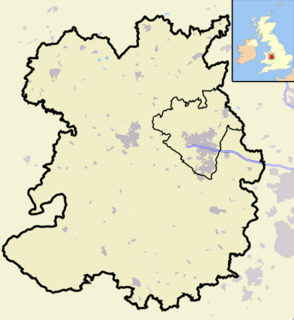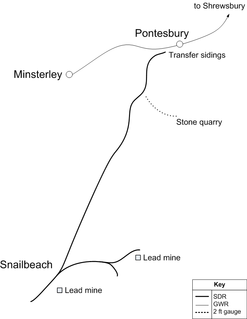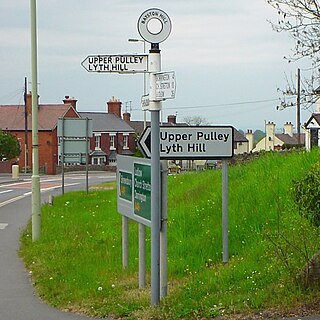
Church Stretton is a market town in Shropshire, England, 13 miles (21 km) south of Shrewsbury and 15 miles (24 km) north of Ludlow. The population in 2011 was 4,671.

Shrewsbury and Atcham was, between 1974 and 2009, a local government district with borough status in Shropshire, England.

Bishop's Castle is a market town in the south west of Shropshire, England. According to the 2011 Census it had a population of 1,893.

The Long Mynd is a heath and moorland plateau that forms part of the Shropshire Hills in Shropshire, England. The high ground, which is common land and designated as an Area of Outstanding Natural Beauty, lies between the Stiperstones range to the west and the Stretton Hills and Wenlock Edge to the east. Much of it is owned by the National Trust, and is managed by the Longmynd Commoners.

The Shropshire Wildlife Trust is a wildlife trust covering the geographic county of Shropshire, England.

The Stiperstones is a distinctive hill in the county of Shropshire, England. The quartzite rock of the ridge formed some 480 million years ago. During the last Ice Age Stiperstones lay on the eastern margin of the Welsh ice sheet. The hill itself was not glaciated though glaciers occupied surrounding valleys and it was subject to intense freezing and thawing which shattered the quartzite into a mass of jumbled scree surrounding several residual rocky tors. At 536 metres (1,759 ft) above sea level it is the second-highest hill in the county, surpassed only by Brown Clee Hill. Stiperstones' 8-kilometre (5 mi) summit ridge is crowned by several jagged outcrops of rock, which may be seen silhouetted against the sky.

Snailbeach District Railways was a British narrow gauge railway in Shropshire. It was built to carry lead ore from mines in the Stiperstones to Pontesbury where the ore was transshipped to the Great Western Railway's Minsterley branch line. Coal from the Pontesford coal mines travelled in the opposite direction. The line ended at Snailbeach, the location of Shropshire's largest and richest lead mine, though there had been a plan to extend it further, which would have brought it closer to more lead mines.

Pontesbury is a village and civil parish in Shropshire and is approximately eight miles southwest of Shrewsbury. In the 2011 census, the village had a population of 1,873 and the parish had a population of 3,227. The village of Minsterley is just over a mile further southwest. The A488 road runs through the village, on its way from Shrewsbury to Bishop's Castle. The Rea Brook flows close by to the north with the village itself nestling on the northern edge of the Shropshire Hills AONB. Shropshire County Council in their current Place Plan detail the development strategy and refer to Pontesbury and neighbouring Minsterley as towns.

The name Rea Brook can refer to either of two brooks in Shropshire, England.
Shropshire was established during the division of Saxon Mercia into shires in the 10th century. It is first mentioned in 1006. After the Norman Conquest it experienced significant development, following the granting of the principal estates of the county to eminent Normans, such as Roger De Montgomery and his son Robert de Bellême.

Bayston Hill is a large village and civil parish in central Shropshire, England. It is 3 miles (5 km) south of the county town Shrewsbury and located on the main A49 road, the Shrewsbury to Hereford road.

Minsterley is a village and civil parish in Shropshire, England. In the 2011 census, its population was 1,777. Minsterley lies one mile south-west of Pontesbury and 10 miles south-west of Shrewsbury. East from Minsterley along the A488, is the larger village of Pontesbury and to its south the hill range, the Stiperstones. The Rea Brook flows nearby and the smaller Minsterley Brook flows through the centre of the village.
Shropshire's Geology is very diverse and most geological periods of time, and most rock types, can be found within the county. There is also a large amount of mineral wealth in the county, including lead, barytes, limestone, coal and iron, which helped the area develop the industrial revolution west of Clee Hill and, later, in the Ironbridge Gorge area. Quarrying is still active, with limestone for cement manufacture and concrete aggregate, sandstone, greywacke and dolerite for road aggregate, and sand and gravel for aggregate and drainage filters. Groundwater is an equally important economic resource.
New Riverside is a £150m shopping centre redevelopment project in Shrewsbury, Shropshire, England, which is planned to link the town's Pride Hill and Darwin centres and comprehensively redevelop the Riverside centre site.
The 1990 Bishop's Castle earthquake occurred near the town of Bishop's Castle, Shropshire, England on 2 April.
Linley is a hamlet in Shropshire, England. It is part of the civil parish of More.
National Cycle Network Route 44, part of the National Cycle Network, connects Shrewsbury, Shropshire with Cinderford, Gloucestershire. The part of the route from Shrewsbury to Bromfield is signed - the remainder of the route is currently unsigned.
The Longmyndian Supergroup is a 6,000-metre-thick (20,000 ft) sequence of Late Precambrian rocks that outcrop between the Pontesford–Linley Fault System and the Church Stretton Fault System in the Welsh Borderland Fault System. The supergroup consists of two major geological groups, the Stretton Group and the overlying Wentnor Group. The rocks are a generally regressive sequence from basinal facies to clastic sedimentation. The rocks are thought to be derived from Uriconian mountains that were formed during the southward subduction of an oceanic plate beneath a continental block. The rocks have since been folded due to fault movements and plunge gently to the south.
Pontesbury is a civil parish in Shropshire, England. It contains 93 listed buildings that are recorded in the National Heritage List for England. Of these, five are listed at Grade II*, the middle of the three grades, and the others are at Grade II, the lowest grade. The parish is to the southwest of Shrewsbury. It contains a number of villages and smaller settlements, including Pontesbury, Pontesford, Plealey, Asterley, Cruckton, Cruckmeole, Arscott, Malehurst, and Habberley, and is otherwise rural. Most of the listed buildings are houses, cottages, farm houses and farm buildings, a high proportion of which are timber framed, or have timber framed cores, and the earliest of these have cruck construction. The other listed buildings include two small country houses, churches and chapels, items in the churchyards, and public houses.












